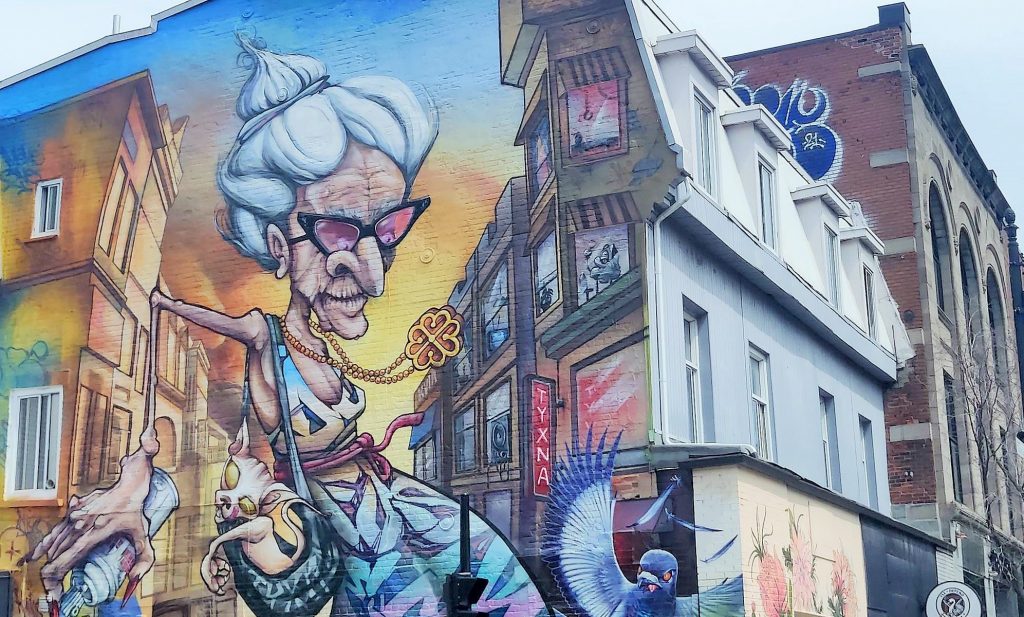Montreal is a city where art and real estate intertwine in a unique alchemy. Through murals, galleries, festivals, and community centers, culture shapes neighborhoods, influences residential trends, and attracts a diverse and creative population. In this article, we explore the most artistically vibrant neighborhoods of Montreal and examine how this cultural dynamism impacts the real estate market.
Plateau-Mont-Royal: The Cultural Classic
You can’t talk about culture in Montreal without starting with the Plateau. Historically linked to the artistic bohemian class, the neighborhood is filled with independent bookstores, theatrical cafés, small venues like La Licorne and Théâtre d’Aujourd’hui, and iconic murals along Saint-Laurent and Saint-Denis. In June, the MURAL Festival turns the streets into an open-air museum.
Real estate impact: Demand remains high, especially for plexes (duplexes, triplexes), though prices have soared. Artists are often replaced by more affluent residents, but the neighborhood’s artistic DNA remains a key draw.
Mile-End: The Creative Epicenter
Once a working-class district, Mile-End has become a hub of alternative culture. It’s home to artist collectives, recording studios like Hotel2Tango, anarchist bookstores, and a vibrant music scene. It also birthed bands like Arcade Fire and Godspeed You! Black Emperor.
Real estate impact: Gentrified but still relatively affordable compared to the Plateau, Mile-End attracts young creatives and freelancers. The mix of uses (lofts, studios, apartments) is a valuable asset.
Hochelaga-Maisonneuve: The Artistic Rise
Long considered underprivileged, HoMa has experienced a surprising cultural resurgence over the last decade. Galleries like Galerie C.O.A., initiatives such as the Chromatic Festival, and revamped public spaces like Promenade Ontario all signal this transformation.
Real estate impact: Condo and renovated apartment prices are climbing but remain attractive. As a “neighborhood in transition,” it’s popular with buyers looking to get ahead of the market.
Rosemont – La Petite-Patrie: Family Creativity
This area blends quiet residential streets with pockets of commercial activity (Plaza Saint-Hubert, rue Beaubien). It attracts young, often family-oriented residents who value access to local culture. Cinéma Beaubien, children’s workshops, and neighborhood festivals are daily cultural staples.
Real estate impact: Very stable, with strong rental demand and steady appreciation potential for plexes and condos.
The Village / Centre-Sud: Alternative Scene and Inclusivity
With emerging galleries, LGBTQ+ collectives, and community projects, the Village offers a cultural scene rooted in diversity. It’s also home to street art initiatives and open cultural experiences (street shows, activist art, small theaters).
Real estate impact: Still affordable in parts, especially south of Sainte-Catherine, the area appeals to artists and young professionals seeking meaning and social diversity.
Griffintown: Contemporary Art Meets New Development
A rapidly growing neighborhood, Griffintown integrates contemporary art into its urban design—murals, sculptures, and urban installations. Galleries like Arsenal Montréal and pop-up exhibits in condos showcase this trend.
Real estate impact: Dominated by condo towers and heavy investment, its cultural offerings enhance the neighborhood’s prestige.
Verdun: Cultural Rebirth
Once overlooked, Verdun is now enjoying a renaissance thanks to the arrival of young families, local businesses, and cultural initiatives like Quai 5160 (Maison de la culture), book cafés, and creative workshops.
Real estate impact: Prices have surged, but the quality of life and cultural access continue to attract newcomers.
Villeray: Neighborhood Culture and Local Life
With lively libraries, dance studios, and cultural parks like Jarry, Villeray offers a family-friendly vibe infused with artistic energy. It values proximity and a strong creative community.
Real estate impact: Plex values remain stable, but rental demand is strong—ideal for investors focused on quality tenants and long-term sustainability.
🎨 When Art Redefines the City and Its Value
Montreal’s artistic neighborhoods are far more than open-air galleries — they are true engines of urban transformation. Each mural, each studio, each independent café draws in new residents, fuels local businesses, and gradually reshapes real estate dynamics.
Living or investing in these areas isn’t just about enjoying an inspiring environment — it’s about becoming part of a story in motion, where creativity shapes everyday life. True to its reputation as a cultural metropolis, Montreal continues to evolve through the energy of its artists, residents, and builders.
In this intersection of art and real estate, we find a city that never stops reinventing itself — and that offers everyone the chance to contribute to its vibrancy.

